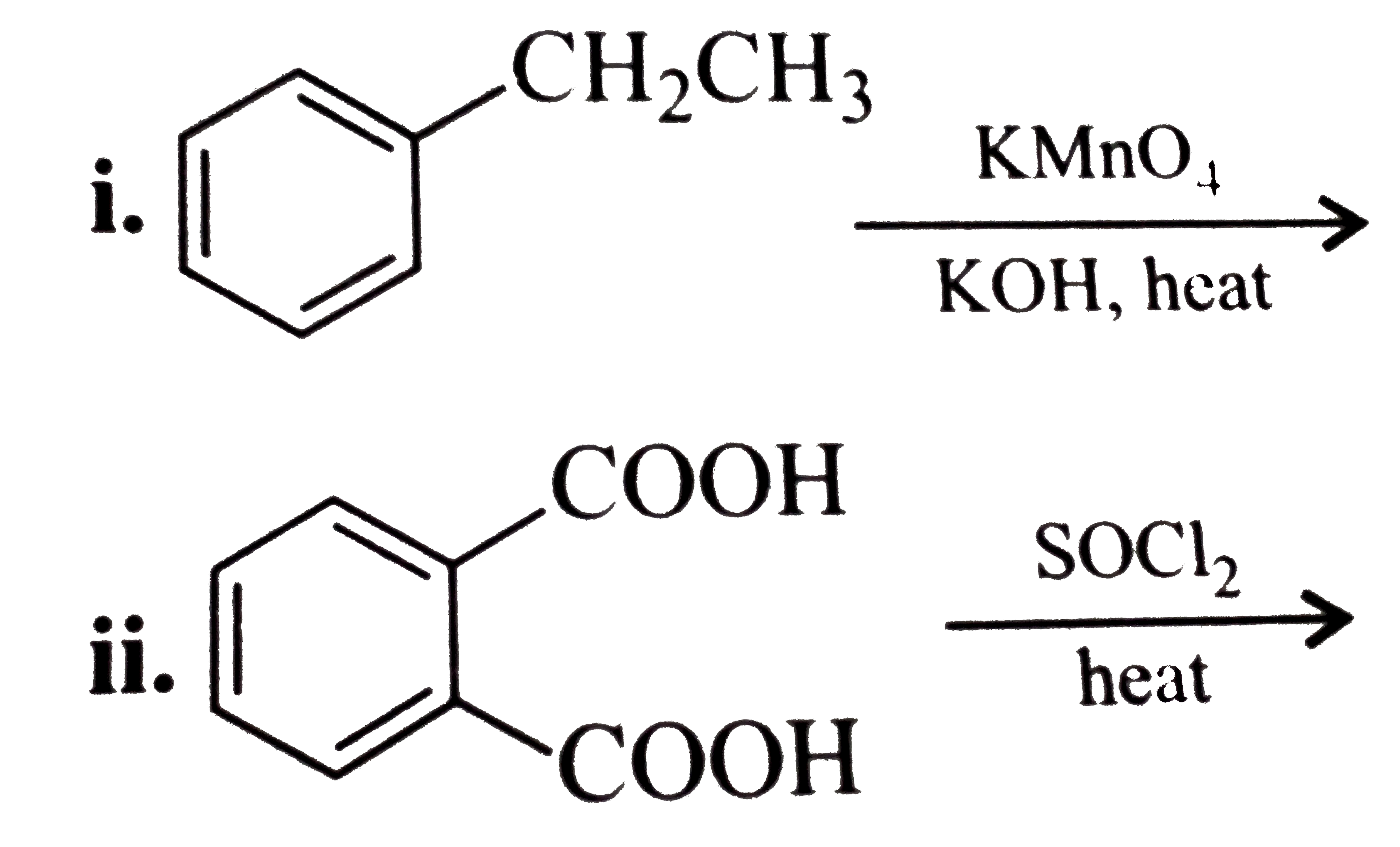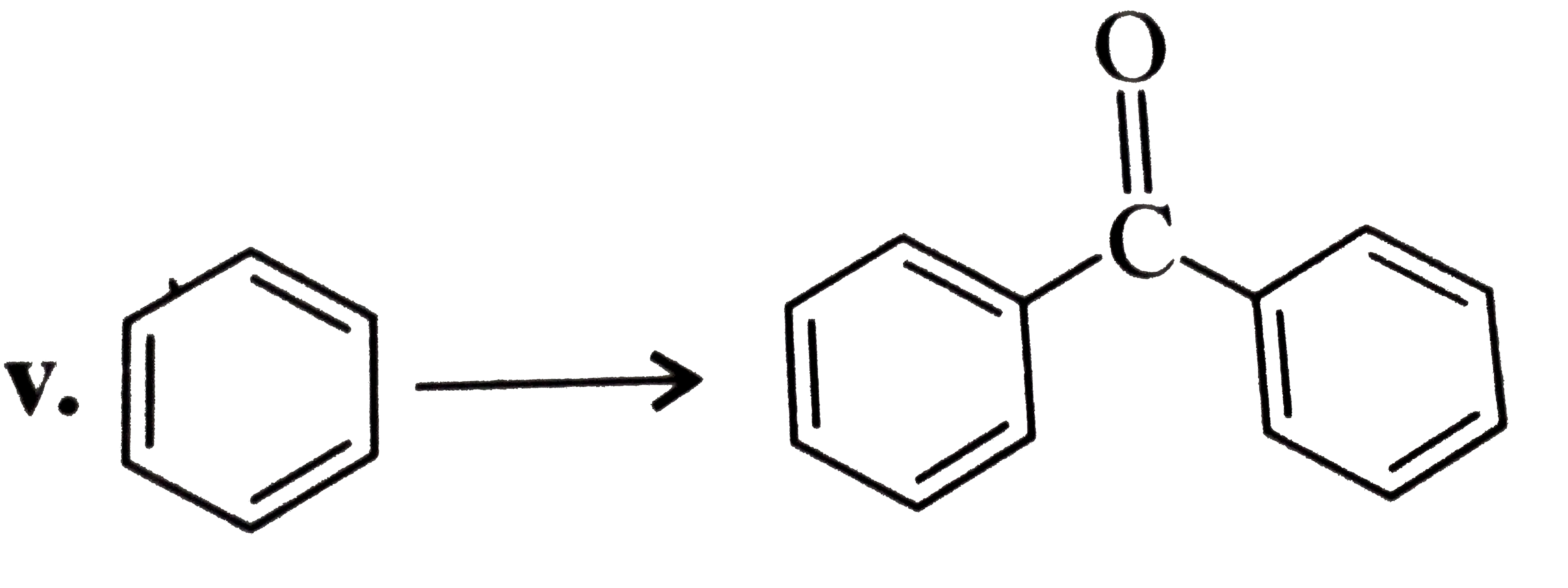How many of the following reagents react with arene diazonium slats to form aryl halides?
i. HBF4/Δ
ii. KHS
iii. CuCN/KCN
iv. CuBr/HBr
v. Cu/HCl
vi. KI/Δ
vii. CH3CH2OH
viii. H3PO2/H2O
The correct Answer is:4
To determine how many of the given reagents react with arene diazonium salts to form aryl halides, we will analyze each reagent one by one.
1. Identify the nature of arene diazonium salts:
Arene diazonium salts have the general formula Ar-N₂⁺X⁻, where Ar is an aryl group and X is a halide (like Cl⁻). These salts can undergo various reactions to form different products.
2. Reagent i: HBF₄/Δ
- Reaction: Arene diazonium salts react with HBF₄ upon heating to form aryl fluorides.
- Product: Yes, it forms aryl halide (fluorobenzene).
3. Reagent ii: KHS
- Reaction: This reagent does not typically react with arene diazonium salts to form aryl halides.
- Product: No, it does not form aryl halide.
4. Reagent iii: CuCN/KCN
- Reaction: Arene diazonium salts react with CuCN to form aryl cyanides (not halides).
- Product: No, it does not form aryl halide.
5. Reagent iv: CuBr/HBr
- Reaction: Arene diazonium salts react with CuBr in the presence of HBr to form aryl bromides.
- Product: Yes, it forms aryl halide (bromobenzene).
6. Reagent v: Cu/HCl
- Reaction: Arene diazonium salts react with Cu in the presence of HCl to form aryl chlorides.
- Product: Yes, it forms aryl halide (chlorobenzene).
7. Reagent vi: KI/Δ
- Reaction: Arene diazonium salts react with KI upon heating to form aryl iodides.
- Product: Yes, it forms aryl halide (iodobenzene).
8. Reagent vii: CH₃CH₂OH
- Reaction: This reagent does not react with arene diazonium salts to form aryl halides.
- Product: No, it does not form aryl halide.
9. Reagent viii: H₃PO₂/H₂O
- Reaction: This reagent reduces arene diazonium salts to form aryl compounds, but not halides.
- Product: No, it does not form aryl halide.
Summary of Reactions:
- Reagents that form aryl halides:
- HBF₄ (i)
- CuBr/HBr (iv)
- Cu/HCl (v)
- KI (vi)
Total Count:
Out of the eight reagents, four reagents (i, iv, v, vi) react with arene diazonium salts to form aryl halides.
Final Answer: 4 reagents react with arene diazonium salts to form aryl halides.
Arene diazonium salts have the general formula Ar-N₂⁺X⁻, where Ar is an aryl group and X is a halide (like Cl⁻). These salts can undergo various reactions to form different products.
- Reaction: Arene diazonium salts react with HBF₄ upon heating to form aryl fluorides.
- Product: Yes, it forms aryl halide (fluorobenzene).
3. Reagent ii: KHS
- Reaction: This reagent does not typically react with arene diazonium salts to form aryl halides.
- Product: No, it does not form aryl halide.
- Reaction: Arene diazonium salts react with CuCN to form aryl cyanides (not halides).
- Product: No, it does not form aryl halide.
- Reaction: Arene diazonium salts react with CuBr in the presence of HBr to form aryl bromides.
- Product: Yes, it forms aryl halide (bromobenzene).
- Reaction: Arene diazonium salts react with Cu in the presence of HCl to form aryl chlorides.
- Product: Yes, it forms aryl halide (chlorobenzene).
- Reaction: Arene diazonium salts react with KI upon heating to form aryl iodides.
- Product: Yes, it forms aryl halide (iodobenzene).
- Reaction: This reagent does not react with arene diazonium salts to form aryl halides.
- Product: No, it does not form aryl halide.
- Reaction: This reagent reduces arene diazonium salts to form aryl compounds, but not halides.
- Product: No, it does not form aryl halide.
- Reagents that form aryl halides:
- HBF₄ (i)
- CuBr/HBr (iv)
- Cu/HCl (v)
- KI (vi)
Out of the eight reagents, four reagents (i, iv, v, vi) react with arene diazonium salts to form aryl halides.
Topper's Solved these Questions
Similar Questions
निम्न में से कितने अभिकर्मक एरिल हैलाइड के निर्माण के लिए एरीन डाइऐजोनियम लवण के साथ अभिक्रिया करते हैं?
i. HBF4/Δ
ii. KHS
(iii) CuCN/KCN
(iv) CuBr/HBr
(v) Cu/HCl
(v) Cu/HCl
(vi) KI/Δ
(vii) CH3CH2OH
View SolutionHow many of the following are ambidentate ligands?
i. co
ii. CN
iii. F
iv. OH−
v. SCN
vi. NO−2
vii. CH3NH2
viii. H2N(CH2)2NH2
View Solution
Knowledge Check
Which of the following reaction(s) can be used for the preparation of alkyl halides?
(I) CH3CH2OH+HClanh.ZnCl2−−−−−−→
(II) CH3CH2OH+HCl→
(III) (CH3)3COH+HCl→
(CH3)2CHOH+HClanh.ZnCl2−−−−−−→A(I) and (II) onlyB(IV) onlyC(III) and (IV) onlyD(I), (III) and (IV) only
Complete the reaction of benzene diazonium chloride with :
(i)H2O/H2SO4
(ii) CuBr/HBr.
View SolutionClassify the following into polar and non-polar molecules:
(i) CO2, (ii) CHCI3, (iii) CCI4, (iv) CH3OCH3,
(v) C2H5OH, (vi) C2H6, (vii) CH2CI2, (viii) NH3, (ix) H2O, (x) CH3CI.
View SolutionWirte IUPAC names of the following compounds and classity them into primary , secondary and tertiary amines .
i. (CH3)2CHNH2 ii. CH3(CH2)2NH2
iii. CH2NHCH(CH3)2 iv. (CH3)3CNH2
v. C6H5NHCH3 vi. (CH3CH2)2NCH3
vii. m−BrC6H4NH2
View SolutionHow many of the following compounds from HCl on hydrolysis as one of the products (major or minor)
(i)BCl3 , (ii)BiCl3 , (iii)SO2Cl2 (iv)NCl3 (v)PCl5 (vi)CrO2Cl2 (vii)CH3Cl (viii)NaCl
View SolutionComplete each synthesis by giving the missing starting material, reagent, or products.
i.
ii.
iii. C6H5CHOH2NCONHNH2−−−−−−−−−→
iv.
v.
vi.
vii. C6H5CHO+CH3CH2CHODil.NaOH−−−−−−→
viii. CH3COCH2COOC2H5(i)NaBH4−−−−−−→(ii)H+
ix.
x.
xi.
View SolutionHow many of the following reagents can convert alkenes into alcohols
i) B2H6/THF,H2O2/OH−
ii) Dil.H2SO4
iii) CH3COO)2,"Hg/THF,NaBH4/H2O
View SolutionWrite the mechanism of the following reaction
CH3CH2OHHBr−−→CH3CH2Br+H2O.
View Solution
